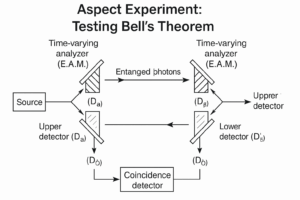The Aspect Experiment: Quantum Entanglement, Bell’s Theorem, and Reality

The Aspect Experiment: Quantum Entanglement, Bell’s Theorem, and Reality
In 1982, Alain Aspect conducted one of the most famous experiments in modern physics — a test of quantum entanglement that challenged the very nature of reality. This experiment sought to determine whether the world is governed by local, deterministic rules (as Einstein believed), or if the universe allows for non-local, instantaneous connections (as quantum mechanics predicts).
🔍 The Goal
The goal of the Aspect experiment was to test Bell’s inequalities using entangled photons. If quantum mechanics is correct, these inequalities would be violated. If Einstein’s local realism holds, the inequalities should stay intact.
🧪 Experimental Setup
Aspect’s team produced entangled photons using calcium atoms. These photons traveled in opposite directions to two detectors equipped with rapidly switching polarizers. The angle of these polarizers changed quickly and randomly after the photons were emitted — ensuring that no “signal” could travel between them and influence the outcome.

⚙️ Technical Innovations
- Time-varying analyzers: Polarizers switched during the photons’ flight, ensuring no local signal could coordinate the outcomes.
- Cascade photon pairs: Emitted by calcium atoms in entangled states.
- Measurement of correlation vs. angle: Quantum mechanics predicts a
cos²(θ)correlation; local realism predicts a linear falloff.
📈 The Result
Aspect’s experiment violated Bell’s inequalities in agreement with quantum predictions. This proved that:
- Local hidden variable theories cannot explain quantum correlations.
- Quantum mechanics allows for non-local effects.
- Nature may be fundamentally probabilistic.
🌀 Visualizing the Quantum
Aspect’s findings supported the Wheeler-Feynman absorber theory — a time-symmetric model where particles send and receive waves both forward and backward in time. This framework explains how two particles can correlate outcomes without communicating in the classical sense.
🔐 Loopholes and Beyond
Aspect’s experiment addressed the locality loophole using fast switching. Later experiments would close the detection loophole and implement quantum random number generators to ensure complete independence between measurements.
🌌 Conclusion
The Aspect experiment is a cornerstone of quantum physics. It revealed a universe where entanglement is real, locality can be violated, and reality isn’t quite what it seems. It opened the door to quantum information science and forced physicists and philosophers alike to rethink the fabric of the cosmos.